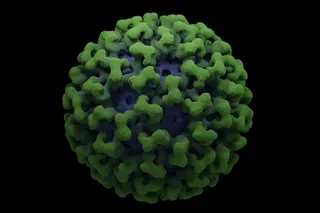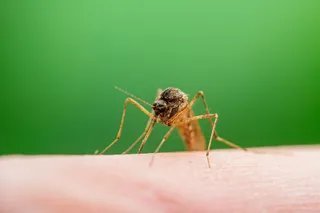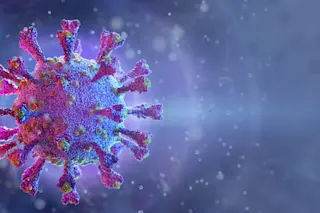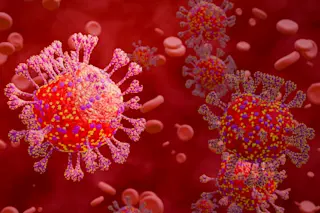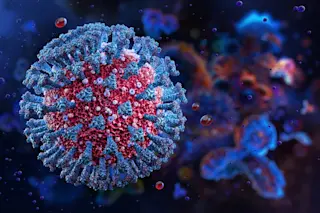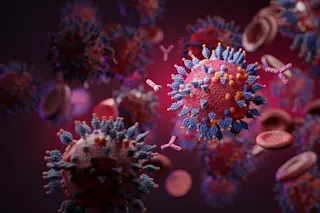On October 2, 1980, a 47-year-old woman from south lake Tahoe, California, lost her 9-month-old pet cat to an acute infection. Three days later, the woman's own temperature shot up, but she still went to her job at a day-care center. The fever worsened; she developed chest pains and shortness of breath. Two days later she drove herself to the hospital. The diagnosis was pneumonia, and she was treated with tetracycline. Shortly afterward the woman died.
Not until four days later did anyone realize that the woman had died of plague. Fearing that treatment might arrive too late, doctors rushed prophylactic antibiotics to the children and staff at the day-care center. Luckily, no one exposed to the woman fell ill. In this country, we tend to think that the horrors of plague are confined safely to the past. Plague, the black death, burned through the medieval world of Europe, killing about one of every four people. But by the mid-18th century, epidemic plague had died down. The terrible days of deserted cities and heaps of the dead fell into the dim past on the Continent, although plague never disappeared—more than 10 million died of it in India less than a century ago.
Plague's current sluggishness poses a number of questions: How could a disease that does not seem to be highly contagious, as evidenced by the story of the woman who worked at the day-care center, slaughter millions in a short period of time? Why does plague move from a smoldering to an explosive phase, and back again? And most important, is it possible that epidemic plague could return?
For biodefense experts the questions are serious, but they are not always about plague. "To Russian and American scientists, plague and anthrax seem like mirror images of one another. We worry about anthrax; they worry about plague," says Paul Keim, a molecular biologist at Northern Arizona University who specializes in the DNA fingerprinting of dangerous pathogens. Keim says anthrax terrifies our scientists more than plague because anthrax spores remain indestructible for long periods of time. A bioterrorist attack with anthrax could render an area infective for generations.
Unlike anthrax, which can be successfully quarantined, plague has shown in huge epidemics that it can spread remarkably fast. Biological warfare experts both here and in the former Soviet Union tried to turn plague into a weapon. And in the 1980s the Soviets succeeded in arming plague with genes that protect it from antibiotics. Igor V. Domaradskij, former deputy chairman of the Interagency Science and Technology Council on Molecular Biology and Genetics, says that he and his associates developed a stable plague strain resistant to several antibiotics.
The American experience with plague has focused on outbreaks among wild rodent populations throughout the western United States. The disease rarely strikes people. When it does, the cause is usually exposure to plague-infected animals and their fleas. Since 1924, there have been no documented cases of person-to-person transmission of plague in this country.
To understand the threat of plague, we must learn not only how plague survives and spreads within its hosts but also how it spreads among them. Only by considering how plague has slipped in and out of human populations can we evaluate the threat of genetically engineered plague.
Yersinia pestis, the bacterium that causes plague, probably descended from Yersinia pseudotuberculosis, one of a group of relatively benign intestinal diseases. Sometime in the past 1,500 to 20,000 years, Y. pestis lost a set of genes for proteins called adhesins, which bind the bacteria to intestinal walls. Robert Brubaker, a microbiologist and plague expert at Michigan State University, suggests that the loss of those genes may have enabled Y. pestis to move with deadly speed throughout the host. Overriding the body's defenses by suppressing the signaling between key immune cells, plague races through the lymphatic system, invading organs such as the spleen, the lungs, and especially the liver.
The bacterium normally thrives in rodent populations, passing from one animal to another via the bites of plague-infected fleas. How the germ is transmitted to humans determines how the disease takes hold. If a person is bitten by a plague-infected flea, agonizingly painful egg-sized swellings of the lymph nodes called buboes develop in the neck, the armpit, or the groin. Buboes give one type of plague its name—bubonic. Without prompt and massive antibiotic treatment, 50 to 60 percent of those infected with this form of plague will die. An even deadlier form, pneumonic plague, develops when a person inhales Y. pestis. In the United States, plague cases tend to crop up in the bubonic form, usually among people in the American Southwest who have been exposed to prairie dogs or ground squirrels and their fleas. The handful of American cases in humans have occurred by zoonosis—transmission from animals. Specifically; the cause is always flea bites or direct exposure to a sick animal.
May Chu, chief of the diagnostic reference section of the bacterial zoonoses branch of the Centers for Disease Control and Prevention (CDC) in Fort Collins, Colorado, deals with Y. pestis on a regular basis. In her lab are ordinary test tubes half-filled with a straw-gold liquid in which many tiny white clumps of the pathogen hang suspended. There are also petri dishes filled with dark-red sheep's blood agar, streaked with the lacy white colonies of plague. When the tubes and vials are opened, researchers sit before a glass partition that shields their faces. "We've been working with plague since the 1960s, and no one yet has become infected," Chu says.
How could such a sluggish disease have given rise to three sweeping epidemics? The Third Pandemic in Asia early in the 20th century killed 10 million people, the medieval black death probably killed more than a quarter of Europeans, and Justinian's plague, which broke out in A.D. 542, raged for about 50 years, killing 100 million people. Chu, like many scientists, attributes the spread to medieval living conditions: fleas, rats, poor hygiene, poor nutrition, and crowding.
Anyone who has visited the medieval cities of Carcassonne or Montpellier, France, which were once nearly depopulated, can easily imagine what happened. While vast areas of medieval Europe were uncultivated forests and wastelands, cities like these, usually shut within high stone walls, were far more densely populated than today. Refuse streamed down narrow culverts in streets; large families lived in cramped houses. Rattus rattus, the black rat, was everywhere, as were rat fleas. It is easy to imagine the reported clouds of infected fleas rising from dead hosts to bite others.
But were multitudes of infected rats and fleas the crucial element in the spread of these epidemics? From the Third Pandemic, which began in Yunnan Province in China in the late 19th century, come innumerable descriptions of rat epizootics, mass die-offs that immediately precede a human plague outbreak. Dongzheng Yu of the Chinese Academy of Preventive Medicine quotes an ancient poem from Yunnan: "Several days after rat fall, people died just like a wall falls."
But medieval chronicles don't speak of rat falls. In fact, so little mention is made of rats that one English historian proposed that the black death could not have been plague. But a recent analysis of tooth pulp taken from a 14th-century plague cemetery in Montpellier showed it contained Y. pestis DNA.
The great plague expert Wu Lien-teh and his associates established during the Third Pandemic that bubonic plague was not transmitted from person to person; it required a bite from the Y. pestis-infected flea to transmit the disease. Yet medieval chroniclers wrote convincingly that the disease was remarkably contagious. In his introduction to The Decameron, Florentine writer Giovanni Boccaccio describes the outbreak: "This pestilence was so powerful that it spread from the ill to the healthy like fire among dry or oily materials. It was so bad that it could be communicated not only through speaking or associating with the sick but even by touching their clothing or anything else they had touched. . . . The pestilence spread so efficiently that not only did it pass from person to person but if an animal touched the belongings of some sick or dead person, it contracted the pestilence and died of it in a short time."
The speed of the transmission recalls pneumonic plague. The late plague expert Robert Pollitzer suggested in a classic monograph that plague in this form creates the explosive outbreaks that kill off entire families, while bubonic cases appear singly. Still, plague researcher Robert Brubaker doubts that the black death was pneumonic plague. "To my knowledge, there is only one really major historical case of a pneumonic plague epidemic, and that was in Manchuria in 1910," he says. "It was cold weather, and these people were packed together, and they were all breathing in each other's faces." That outbreak killed 50,000 to 60,000 people. Brubaker argues that the black death could have sustained itself with only fleas and rats or some other reservoir animal. "Plague is an animal disease," he says. "Humans are a dead-end, accidental host."
That is the plague we know today: a true zoonosis sustained by infected rodents and the fleas that prey on them. But is it possible that at times during the three pandemics plague actually became a human disease, one that did not depend on transmission from infected rats? It could happen in two ways. Kenneth Gage, plague section chief of the CDC, notes that historically plague may have been transmitted among humans by the so-called human flea, Pulex irritans, or via airborne transmission. Could the black death have begun as a flea-spread disease and adapted during an epidemic to become a highly transmissible airborne disease—and could it do so again?
Evolutionary biologist Richard E. Lenski at Michigan State University has suggested that changes in plague virulence and transmissibility might best be understood from the point of view of the organism's needs. In order to survive and spread, pathogens must adapt to their hosts. The genes of a plague strain that infects marmots, for example, differ from those of the plague strains that infect rats. These changes come about as the better-adapted strains take over, spreading at the expense of less-well-adapted strains within a particular host species.
If such a trend occurred during pneumonic plague transmission among humans, it would make sense of the reports from the Middle Ages. There is no way to test this idea experimentally because the plague strains that swept around the globe have vanished. What remain in certain animal reservoirs are ancient strains, or biovars, which seem to correspond to each of the three pandemics.
What might we see if those vanished epidemic-causing strains were resurrected? First, we would expect variants that succeed in a plague epidemic to be better at infecting human cells and spreading more efficiently among humans than strains circulating in rats or other hosts. Wu Lien-teh, moreover, suggested that virulence increases in the course of an epidemic. Dongzheng Yu conducted a series of experiments in rats to test this idea. He injected them with a strain of plague from wild rodents; the injected rats were not easily infected and died slowly. Next, he withdrew plague bacteria from those rats and injected it into others, and on and on. Eventually, this serial passage produced a plague strain so lethal that rats injected with only a tiny amount died rapidly, suggesting that the strain's virulence had markedly increased.
In a sense, Yu and his syringe played the role of a flea. Perhaps the human flea functioned in the same way to pass on increasingly virulent strains of Y. pestis.Medieval Italy swarmed with fleas. The sinister costume of medieval plague doctors—the long, beaky nosepiece filled with spices, and a cloak of fine waxed cloth—apparently protected them from flea bites.
Nonetheless, Pulex irritans, the human flea, is a much less efficient vector of plague than the rat flea Xenopsylla cheopis. In order to transmit plague, Pulex irritans must bite a host with lots of bacteria in the blood and pass the bacteria on to the next host quickly. Thus the virulence of a disease transmitted by the human flea should markedly increase, producing a more rapid course of illness and a higher death toll.
We would also expect human-adapted strains, at least during a pneumonic epidemic, to display greater transmissibility. "To get a toehold in the human population, a newly introduced pathogen must be at least slightly transmissible," says Paul Ewald, a professor of evolutionary biology and author of Plague Time."Using this toehold as a starting point, natural selection would act to increase transmissibility." In other words, those strains that can hop from human to human most effectively will be selected for. After repeated cycling through human hosts, a strongly transmissible strain could develop.
The possibility of increased virulence and transmissibility as the plague cycles in humans makes the development of an antibiotic-resistant plague by Russian bioweapons scientists terrifying. As it stands, most cases of plague can be cured before Y. pestis might begin to spread within the population as an easily transmissible strain of pneumonic plague. Even an attack using nonengineered plague could probably be contained. As David Dennis, coordinator of the CDC's plague program, says, "If it did happen, you could have a horrible circumstance in the first wave, but I am confident that using rationality and discipline we could prevent continuing transmission." Dennis is not speaking of antibiotic-resistant plague.
Russian experts believe plague is so transmissible that almost everyone exposed to a contagious person will catch pneumonic plague. Soviet scientists had assigned a so-called contagion index of nearly one to pneumonic plague. Ken Alibek, former first deputy chief of Biopreparat, the former Soviet bioweapons apparatus, says that this term represents the number of cases of disease divided by the number of people exposed to the pathogen: "The plague weapon has been considered one of the most effective weapons ever created by the Soviet Union."
If first-line antibiotics proved useless in an aerosol attack, almost all those exposed to infective doses of plague would probably die, but not before they spread the infection to many other people. "To fully appreciate the threat," says Ewald, "the problem has to be seen as an evolutionary play that culminates in the creation of a transmissible and destructive adversary, especially if the bioweapons engineers have already given it the shield of antibiotic resistance."
There is no evidence that anyone in Russia is still working on weapons strains of plague. Boris Yeltsin shut down biological weapons research at Biopreparat in 1992. The agency has been converted to a civilian research program, and many former weapons experts in Russia are engaged in joint medical research with American scientists. But the knowledge remains; and some Russian ministry of defense labs are still closed to U. S. officials and scientists. No one knows what the Russians are working on now, nor what became of the former weapons strains of smallpox, anthrax, and plague.
Scientists in the United States do not take plague outbreaks lightly. Every case is listed, tracked, and meticulously investigated. There are experts in all countries with endemic plague who monitor the disease, with the help of the World Health Organization and sometimes the CDC. Given this vigilance, it's unlikely that a natural outbreak could ever have the opportunity to cycle widely enough to produce a pandemic.
But the bioterrorist threat is another matter. Even without genetic engineering, pneumonic plague bombs would make a formidable weapon. In response to the threat, scientists at the U.S. Army Medical Research Institute of Infectious Diseases have developed a new recombinant protein vaccine. Unlike older vaccines, the new vaccine has already proven effective against pneumonic plague in animal models. The vaccine could stop the short-term, sporadic outbreaks that still occur in endemic regions of the world—naturally antibiotic-resistant strains have twice appeared in Madagascar in recent years.
For now, the best defense against plague remains vigilance. Unlike smallpox, plague may never be eradicated, because it can hide in animal reservoirs. Igor Domaradskij put it this way in the introduction to a monograph: "In prior years we were told so often that infections such as plague and cholera had been fully eradicated that outbreaks of cholera . . . caught everyone by surprise. . . . It would be too bad if we did not profit from the lessons of the relatively recent past! For you see, plague may not be like cholera, but like cholera it always comes unexpectedly." Web Resources For a comprehensive look at plague, see the Centers for Disease Control or check out the Center for Civilian Biodefense studies. For more on Biopreparat and other former Soviet biological weapons activities, see the Center for Nonproliferation Studies page.


